
Quick Key Facts
- Eight million tons of plastic reaches our oceans annually. The top plastic marine debris items are cigarette butts, food wrappers, beverage bottles and lids.
- Ocean currents pull plastic into convergence zones called “gyres” that form patches of waste at their centers. The largest is the Great Pacific Garbage Patch, which is twice the size of Texas.
- Plastic is a major threat to aquatic life, killing 100 million marine animals per year.
- Plastic waste degrades quickly in the ocean — especially along shorelines — and sheds microplastics into marine environments.
- Rivers act like arteries, conveying huge amounts of waste to oceans. Just 1,000 rivers are responsible for 80% of all ocean plastic.
- Various technologies are being employed to clean up ocean plastic: Seabin vacuums in litter and microplastics; Wasser 3.0 swirls hybrid silica gels in a vortex to form microplastic agglomerates; the Great Bubble Barrier pushes plastic to the surface of Amsterdam’s canals using air bubbles.
- The Ocean Cleanup is one of the most well-known cleanup efforts in the ocean, primarily targeting the Great Pacific Garbage Patch. The organization aims to eliminate 90% of floating plastic in the oceans by 2040.
- Cleanup efforts have been criticized for their impact on marine ecosystems, particularly the neuston floating on the ocean’s surface and the fish trapped in plastic-catching nets.
Ocean Plastic: The Basics
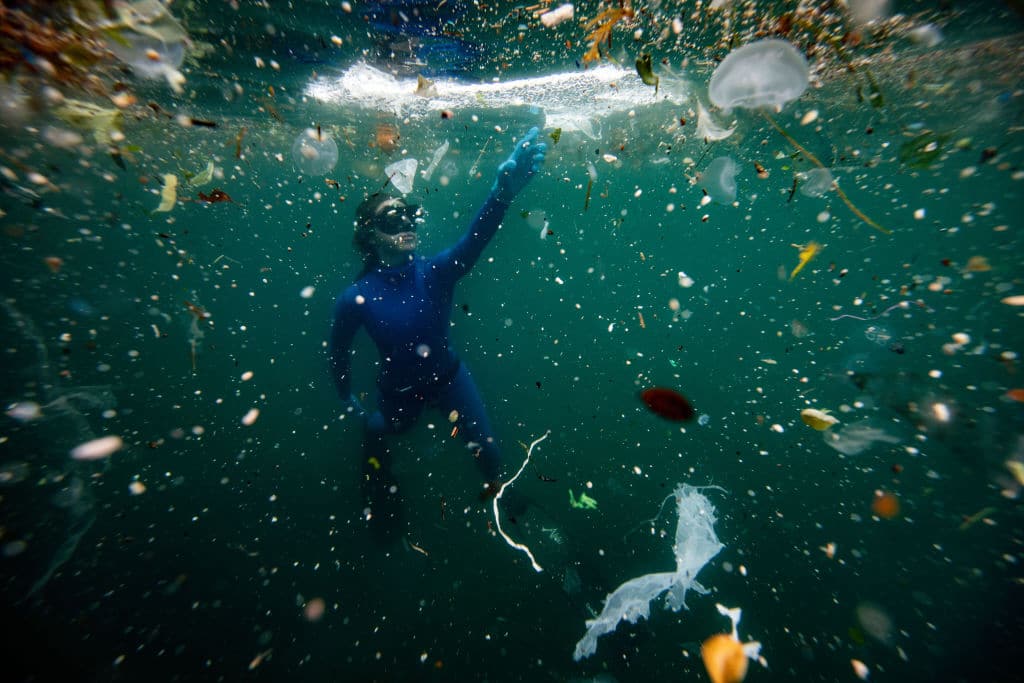
The Earth’s oceans are teeming with life — and with plastic. In fact, by 2050, it’s expected that there will be even more plastic in the ocean than fish.
Adding to the 150 million tons already in marine environments, eight million tons of plastic reaches our oceans every year. While the Ocean Dumping Ban Act of 1988 (also known as the Marine Protection, Research, and Sanctuaries Act) banned dumping waste directly into the ocean in the United States, waste still makes its way into waterways through illegal dumping and other means. Without proper systems worldwide for handling and disposing of waste, it can easily end up in rivers and eventually make its way into the ocean. In coastal areas especially, rainwater can flush litter into storm drains and eventually into the ocean.
Of the 380 million tons of plastic produced every year, 50% is single use products, much of which makes its way into oceans. Some top marine debris items, according to NOAA, are cigarette butts, food wrappers, plastic beverage bottles and lids.
Great Pacific Garbage Patch
When plastic makes its way into the ocean, some of it is pulled by ocean currents to consolidate in specific areas forming “patches” at their centers. There are five of these convergence zones, called “gyres” — one in the Indian Ocean, two in the Atlantic Ocean and two in the Pacific Ocean — and they are often the focus of large-scale ocean cleanup efforts. The Great Pacific Garbage Patch is one of the largest and most well-known patches, and is located in the North Pacific Gyre between Hawaii and California. The patch is 1.6 million square kilometers: 2x the size of Texas and 3x the size of France. Within it are an estimated 1.8 trillion pieces of plastic; some are macroplastics — like cigarette butts, medical waste, plastic bags and bottles, abandoned fishing gear, etc. — but the majority of the debris is made up of microplastics. Overall, the majority (by count) of plastic pieces in the garbage patches consists of those smaller than 5mm in size.
A common misconception of these gyres and patches within them is that they’re just giant, floating mats of garbage. In reality, a lot of the waste floats below the surface of the water, and there are different concentrations throughout the patch itself — so some parts of it just look like regular ocean from above.
Why Is Ocean Plastic a Problem?
Ocean-bound plastic is expected to triple by 2040 if drastic action isn’t taken to reduce both our consumption and our waste management practices. Once plastic reaches the ocean, it causes serious harm to marine life and can impact global economies like fisheries and wildlife tourism.
Microplastics
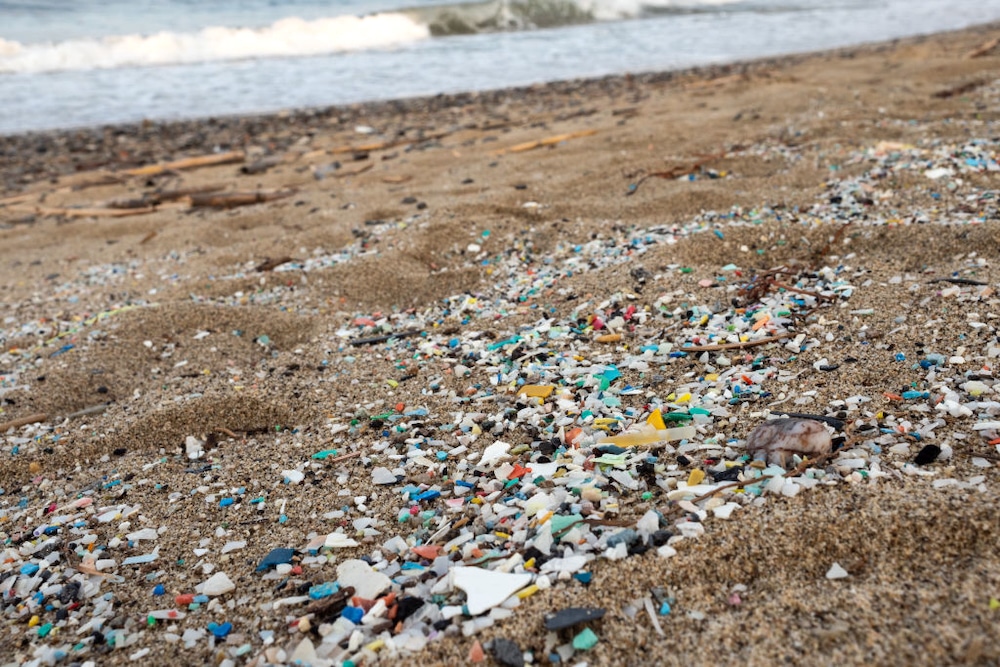
Since the early 2000s, scientists have become aware of the presence of microplastics in oceans, although they’ve lingered in these marine ecosystems since the 1960s. Microplastics are tiny plastic fragments of five millimeters or less in diameter. “Primary” microplastics were created at that size for products like microbeads and plastic fibers used in synthetic fabrics, while “secondary” microplastics form from larger pieces of plastic as they degrade in the environment under the forces of water, wind and UV rays. Microplastics are ubiquitous in our environment now and are found virtually everywhere on Earth, from the deepest trenches of the ocean, to the highest mountains, to the air and water we take into our bodies. In the top foot of seawater alone, it’s estimated that between 82 and 358 trillion plastic particles (about 2.4 to 10.8 billion pounds) are floating.
Microplastics are particularly an issue in oceans, where they degrade more easily and are readily ingested by wildlife — so when plastics enter the ocean, they will eventually shed microplastics as they break down. Because these tiny plastic fragments aren’t filtered out by current sewage technology, removing plastic from the ocean (and preventing it from entering in the first place) is crucial to mitigating the impact of microplastics on marine environments.
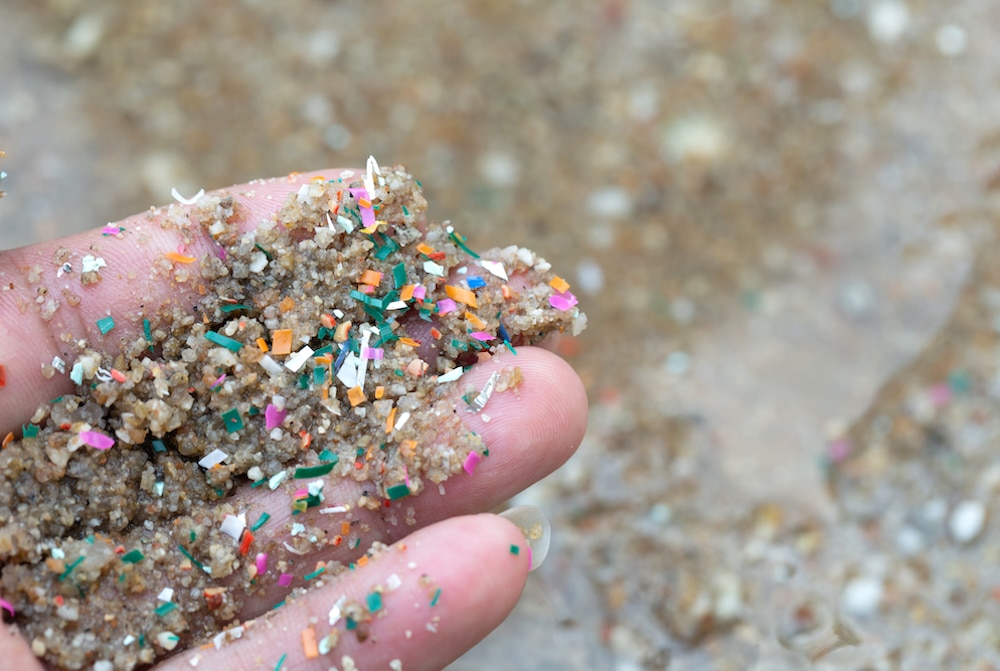
Threats to Marine Life and Ecosystems
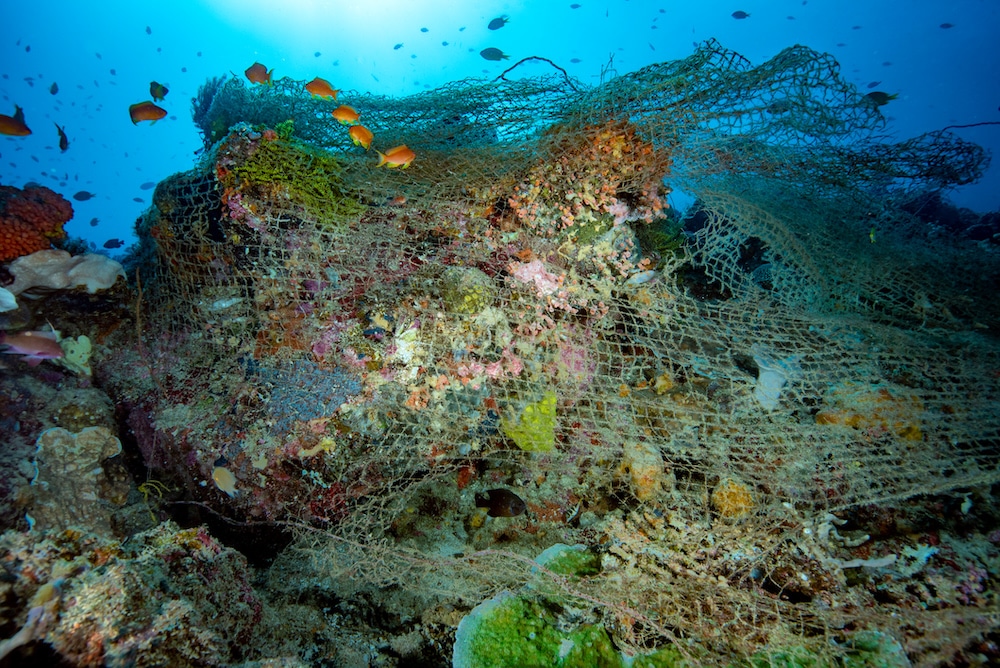
It’s not hard to imagine that millions of pieces of plastic would disrupt natural ecosystems, fundamentally changing their makeup and impacting the species that depend upon them. In all, plastic kills more than 100 million ocean animals per year. Marine life gets entangled in ghost fishing gear like abandoned nets, or other plastic items like grocery bags and six-pack rings. They ingest it too — almost all seabirds on Earth have eaten plastic, as well as half of sea turtles. Filling their stomachs with debris can cause these animals to die of starvation or suffer from internal injuries. Furthermore, debris in these patches can even transport species to other locations — including crabs, algae and barnacles that attach to the plastic — and might become invasive when they settle in new areas.
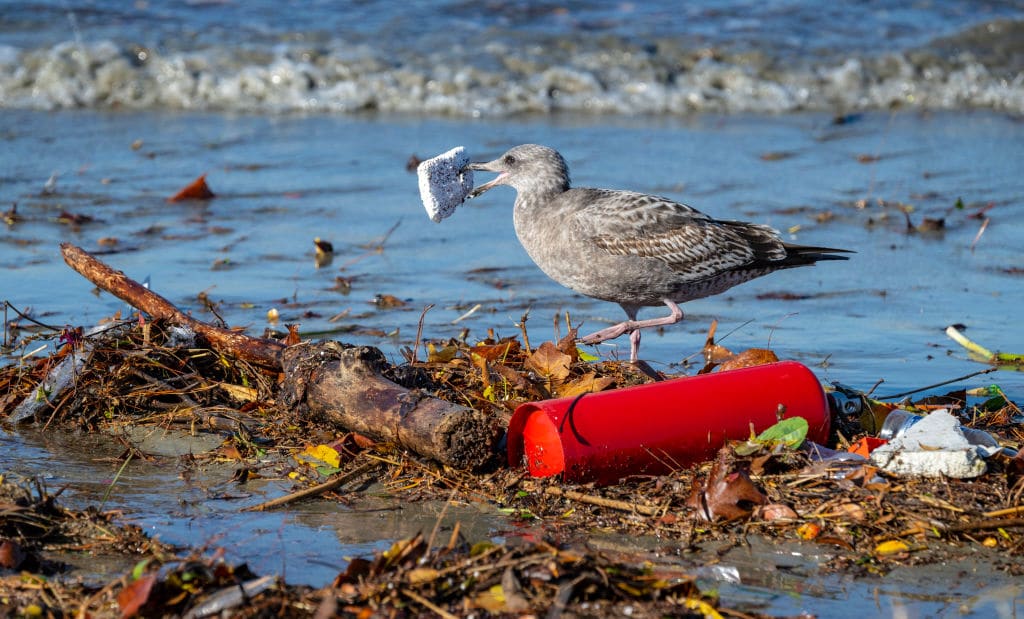
Economic Impacts
Along with their environmental toll, ocean plastics also pose a threat to global economics. It makes ecosystems less resilient by altering biodiversity and other conditions, especially when connected with other stressors like ocean acidification and rising temperatures. Thus, plastic diminishes the ability of marine ecosystems to provide ecosystem services — that is, the beneficial services that ecosystems provide us with, such as carbon storage and climate regulation, recreational opportunities/tourism, waste detoxification, pest and disease control and a source of food for humans. When an ocean is functioning normally, it provides us with these positive (and profitable) ecological functions. It’s estimated that in 2011, marine ecosystem services created value for society of about $49.7 trillion a year — but due to marine plastic, there has been a 1-5% decline in overall ecosystem services, which equates to about $500 billion to $2,500 billion in value lost.
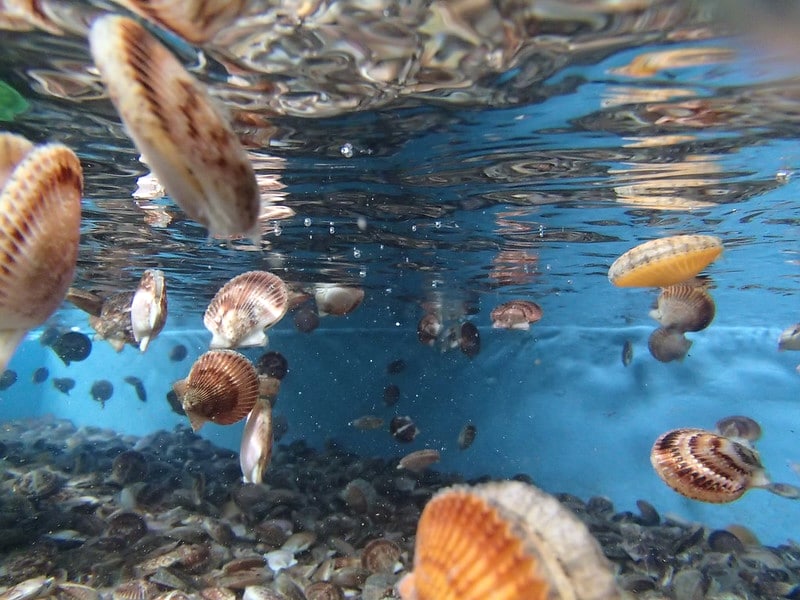
Scallops at an aquaculture farm in Tongoy Bay, Chile. Maria Valladares / NOAA OAR 2014 Photo Contest
The aquaculture industry is especially at risk. Plastic in marine environments can reduce the efficiency of fisheries and threaten fish populations that people depend on for food. Seafood is a principal source of animal protein for humans, and makes up over 20% of food intake by weight for 19% of the global population.
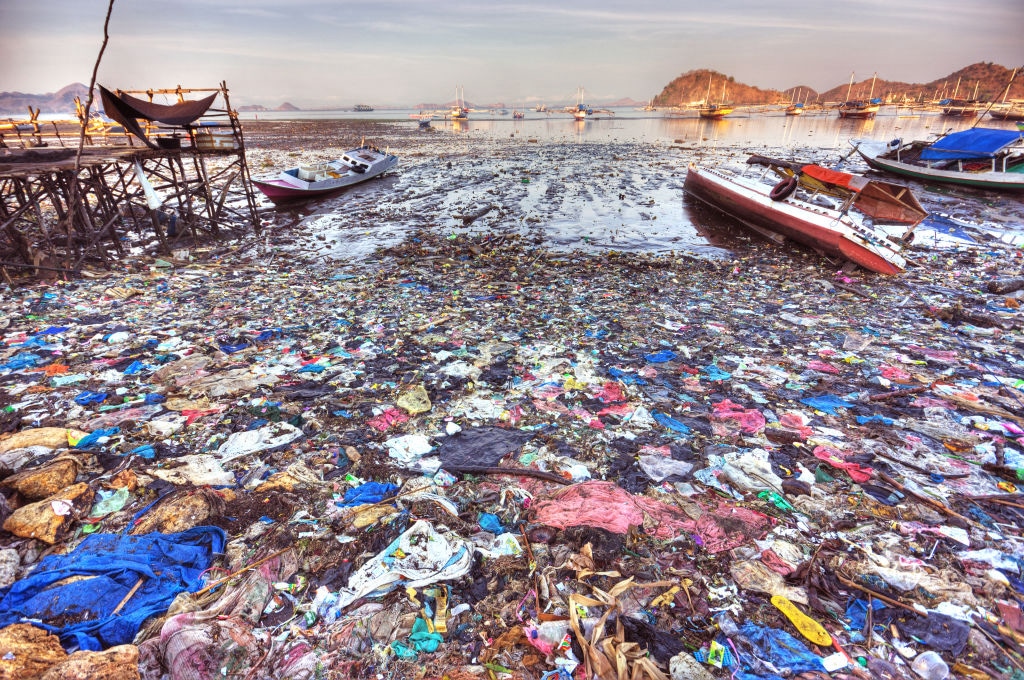
Tourism/recreation is another huge industry that depends on thriving marine ecosystems. Not only does environmental and wildlife tourism provide opportunities for enjoyment and fulfillment all over the globe, but it is also a multi-billion dollar sector that many economies depend on. Losing species that rely on impacted marine environments could mean fewer opportunities for enjoyment, and thus a loss of that crucial income. Species also have cultural value to humans; there is evidence that humans psychologically benefit from merely knowing that marine animals exist in their lives and will continue to live there.
Current Ocean Cleanup Technology
Amidst this gargantuan influx of ocean plastic, new technological innovations have begun targeting marine waste and finding effective ways to both remove it from natural environments and prevent it from ending up there in the first place.
Seabin V5
Seabin V5, launched in Australia in 2015, has set an ambitious target to clean 100 cities of marine debris by 2050. This innovative solution is primarily designed to operate in calm water, like harbors and marinas. As the name implies, the Seabin functions as a floating receptacle, collecting litter floating on the water’s surface as well as substances like oil, fuel and detergents. The device operates akin to a vacuum, drawing in water and catching waste materials, including microplastics. The collected waste is then retained, while the water is filtered and then sent back into the ocean. The potential of Seabin to address plastic pollution in still water is substantial, with projections anticipating the capture of about 90,000 plastic bags per year.
FRED
Developed by the San Diego-based nonprofit Clear Blue Sea, FRED (which stands for Floating Robot Eliminating Debris) emerged through a collaborative effort with high school and college interns and volunteers. The robot has a more specific focus than some other cleanup technologies, targeting mainly plastics prone to disintegrating into microplastics. Operating like a vacuum, FRED can pick up debris from 3cm to 2ft in size, using its two front flaps to direct debris onto a conveyor belt, which moves them into a collection basket. It also has additional front flaps to collect larger pieces of trash as well. Because the robot runs on renewable energy, it’s not at all dependent on fossil fuels. The machine’s slow pace, coupled with sophisticated sensors, effectively prevents marine life from entering and helps it function as a water quality monitor as well. FRED generates underwater maps too, which can help predict the impacts of climate change or runoff from pollution. While it’s a smaller operation, its holistic design that addresses both waste collection and water monitoring is one with great promise.
Wasser 3.0
Hailing from Germany, Wasser 3.0 is tackling microplastic pollution in waterways. The main component is a vortex system that swirls a non-toxic compound composed of hybrid silica gels, drawing in microplastics and causing them to clump into “popcorn-like” agglomerates that float to water’s surface, which can then be easily removed. The process has the potential to serve as a microplastic-removal tool in sewage systems — which currently are unable to filter out microplastics — and is already being used at a municipal wastewater treatment plant in Landau-Mörlheim, Germany, as well as a paper processing facility.
The Ocean Cleanup
Perhaps the most prominent and well-known system in the realm of ocean cleanup is led by The Ocean Cleanup (TOC), a Dutch nonprofit organization founded in 2013 by 18-year-old Boyan Slat. Slat was inspired to start the initiative after taking a family scuba diving trip to Greece at the age of 16, where he was dismayed to see more plastic bags than fish in the water. Backed by funding from Coca-Cola and other large corporations, The Ocean Cleanup has a mission to eliminate 90% of floating plastic in the oceans by 2040.
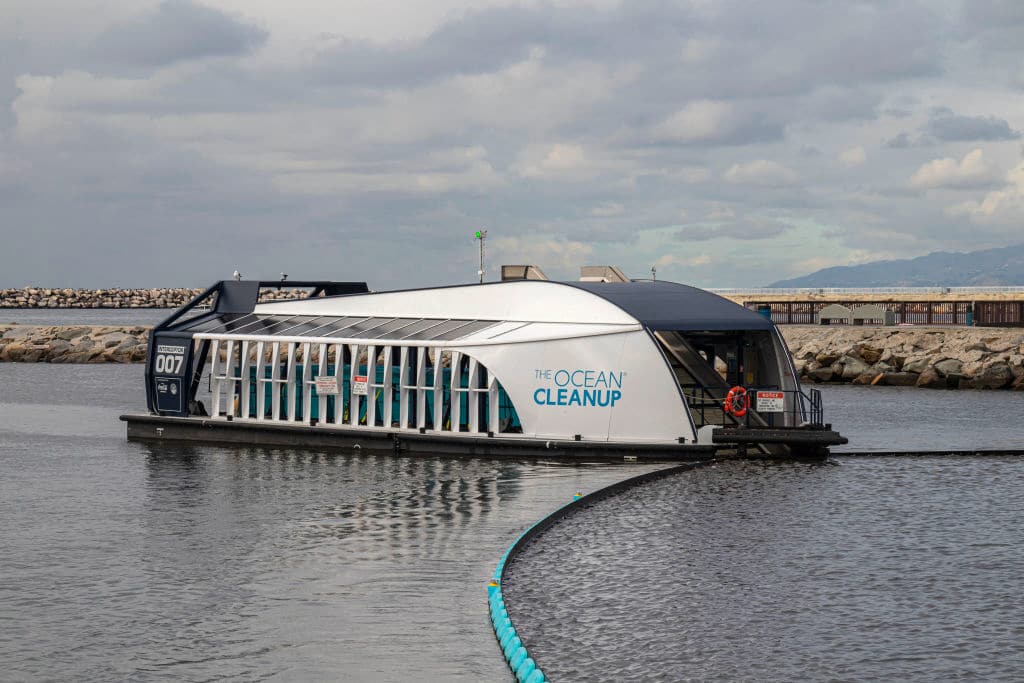
TOC’s system employs a four-step process in collecting waste: target, capture, extract and recycle. Cameras first scan the surface of the water to find plastic hotspots and determine where the cleanup should target, also using computational modeling to predict where plastic hotspots will be based on water currents. Then, plastic is captured in the retention zone using their “Interceptor vessels.” Two boats pull a large U-shaped barrier through the water that goes about 3 meters below the surface, collecting the trash as it moves. The boats come together once a week to close the gap, and the retention zone is taken onboard and emptied onto the vessel. The collected waste is then separated into different recycling streams to send to shore.
The Great Pacific Garbage Patch is TOC’s first target. They began collecting plastic there in 2019, and have been removing it consistently since 2021. Thousands of tons have been collected by now, with around 245,680 kg of trash removed so far. TOC hopes to remove 1% of the patch by the end of 2023. Initially, the organization employed System 001, which proved to be ineffective. Now, however, they’re using System 002 while developing System 03, which will be a whopping 2,400 meters wide, three times larger than System 002, thereby reducing the number of units needed to clean up the patch.
In Rivers
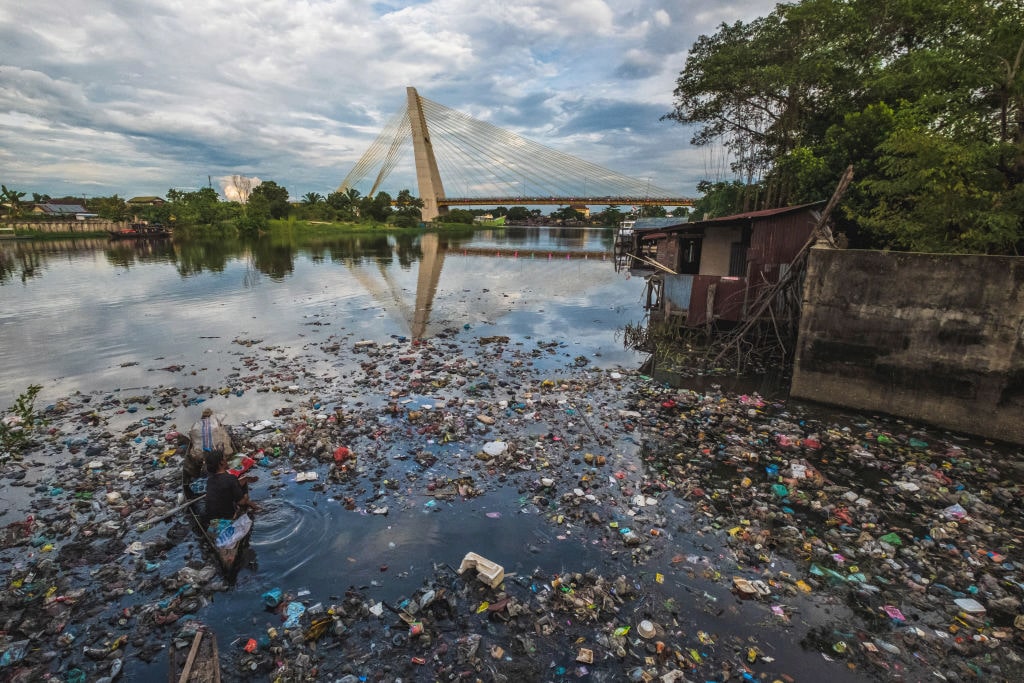
Plastic that’s already in the ocean isn’t the only waste of importance. A huge amount of plastic reaches our oceans via rivers, so effective cleanup methods must also target these arteries to prevent waste from reaching marine environments in the first place. More than 1,000 rivers are responsible for 80% of ocean plastic, according to research conducted by The Ocean Cleanup in 2021. Along with cleaning up the GPGP, TOC’s approach also includes intercepting plastic from 1,000 rivers worldwide — currently, they are doing so at 11 rivers in Vietnam, Indonesia, Jamaica, the Dominican Republic and Malaysia — which they believe could halt 80% of river-based plastic from reaching oceans. They use AI-powered cameras to figure out contributing factors like depth, width and flow speed of the debris, and use their Interceptor vessels to collect waste at the mouth of these rivers and ferry it to waste management facilities.
Mr. Trash Wheel
Who knew a trash collector could be a tourist attraction? Mr. Trash Wheel — created by Clearwater Mills, LLC — resides in the Baltimore Harbor, catching ocean-bound plastic and entertaining visitors with his goofy, giant googly-eyes. The contraption uses two-foot-deep containment booms to collect trash flowing down the river. Water currents power the wheel — or solar power, when the currents aren’t strong enough — which rakes trash and lifts it out of the water and onto a conveyor belt. The trash then falls into a dumpster on another floating barge, which transports it away to be incinerated for electricity. Four such wheels exist across the harbor, known as the “Trash Wheel Family,” which has collected 2,362.23 tons of trash.
The Great Bubble Barrier
This barrier isn’t made of hard materials like many other cleanup systems — instead, it’s made of air. A Dutch startup company created this barrier for the Amsterdam canals to capture plastic through the whole width and depth of a river. The system’s successes include its lack of interference with the river’s regular functions — like ship use and fish passage — and its around-the-clock operation. A perforated tube runs along the bottom of the river and pushes out air at an angle, creating a “screen” of bubbles that blocks plastics and directs them towards the surface of the water into the catchment system. The group expects 86-90% of plastic to be removed in the Oude Rijn in Katwijk, Netherlands via this system.
WasteShark
Inspired by the whale shark, the WasteShark was created in 2018 by RanMarine Technology to clean up waterways, harbors, ponds and lakes, and was recently deployed in New York City’s Hudson River. Like the whale shark — which filters water through its body to ingest krill and plankton — the WasteShark filters water through it to catch plastic waste, as well as algae and other biomass. This small, boat-like drone floats along the water’s surface to collect debris to be taken to land and disposed of, using sensors to avoid obstacles. It also collects information on the water it traverses, like salinity and pH levels.
Problems Related to Ocean Cleanup Efforts
Efficiency and Validity
There has been controversy over whether ocean cleanup technologies are more harmful than helpful, and whether they’re as effective as they’ve claimed to be. In 2022, a video from The Ocean Cleanup of waste aboard one of their vessels prompted calls that the trash was too clean to have come from the ocean, and perhaps was staged, which the organization denies.
There have also been questions of whether their methods themselves are successful. System 001 was ineffective, and System 001B would have required 150 units to effectively clear the GPGP. System 002 has been more successful, but very expensive — although TOC says it will solve some of the issues in earlier systems, such as “overtopping,” by which plastic rode in waves over the top of the barriers.
Habitat Destruction and Bycatch
The Great Pacific Garbage Patch and other gyres aren’t just home to plastic, but also to other floating marine life that have made their home there, or have otherwise gotten caught up in this new ecosystem. Many of these systems — especially those that collect plastic in net-like structures — have the potential to be harmful in the way that trawl fishing is, which catches fish indiscriminately, although these nets are often more shallow and move slowly so the creatures can escape. Along with fish, sharks, and turtles, plastic-catching nets also disturb the neuston: a community of organisms including crabs, sea anemones, insects, snails, worms, nudibranchs and other small creatures that float on the surface of the ocean. The neuston is an important food source for larger species, and given the way it interacts with ocean currents, it often ends up where ocean plastic accumulates.
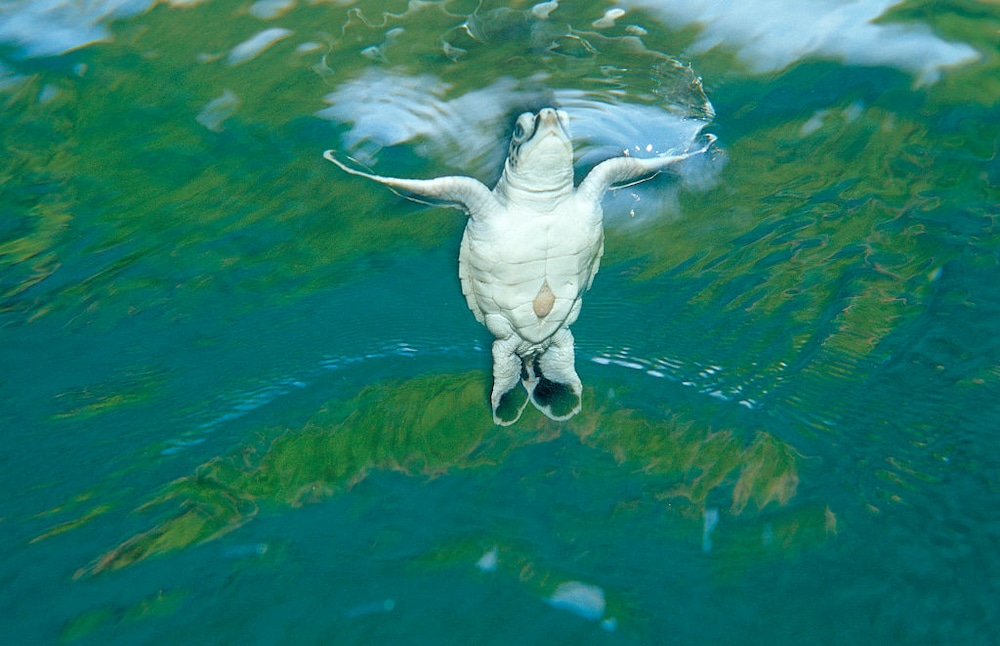
The Ocean Cleanup in particular has come under fire for potential harm to ecosystems. Their systems have caught fish, small sharks, mollusks, and sea turtles accidentally, although the organization does maintain that by weight, it’s a very small amount compared to the plastic. In 40 tons of plastic, 141 kg of biological matter was caught, or 3.6g for every 1,000g of plastic collected. They also claim that fish can escape their catch system through hatches, and they have breathing ports for animals, as well as lights, acoustics and cameras to detect and deter species. The TOC has begun addressing their impact on the neuston as well, and maintains that preliminary data is promising, finding only one type of neustonic organism (Velella velella) had been caught. Seabin has also been criticized for its impact on marine life. A 2022 study found that for every 3.6 pieces of litter captured, so was one marine animal. When examined in a tidal marina, Seabin captured 58 items of litter a day on average, as well as 13 marine organisms, 50% of which were dead upon retrieval.
Energy Use
Many cleanup methods are powered by renewables, but not all of them, begging the question of whether these cleanups are causing greater harm to the climate while they remove trash. Ocean Cleanup ships, for example, are powered by fossil fuels and emit 660 tons of CO2 per month — although the group says that they will offset all emissions from System 002, as they have with 001. However, the legitimacy and ethicality of carbon offsets at large has been hotly debated.
Non-Surface Plastic and Prominence of Microplastics
Most cleanup systems only reach a few feet below the ocean’s surface, but many macroplastics do fall to the ocean floor and are thus missed in cleanup efforts. At such a depth, however, plastics are more likely to become a part of the ecosystem, so a disturbance would be more harmful to wildlife. Similarly, not all cleanup systems capture microplastics, which we know are an extremely significant source of harm in marine environments. During the first 5 years after being released into the ocean, 77% of floating plastic is found close to the shore where it erodes faster into microplastics. There is an argument to be made that beach cleanups and efforts closer to land would be more productive at ridding the ocean of microplastics — or dealing with plastic at the source by preventing its introduction into waterways at the outset. Some argue that focusing so heavily on ocean cleanup diverts attention away from addressing the creation and poor disposal of plastics in the first place.
What Action Can We Take?
Reduce Single-Use Plastics
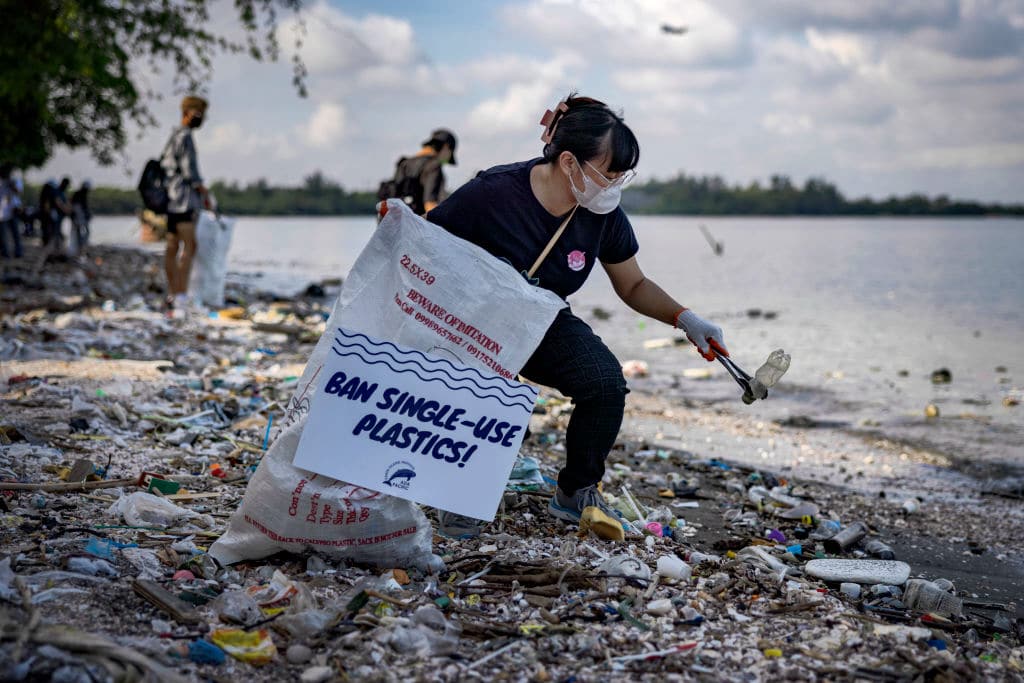
At our current rate of consumption — and as the global population expands and becomes more affluent — plastic use is expected to triple by 2060, according to the Organization for Economic Cooperation and Development Projects. To eliminate plastic waste from oceans, we must combat the source rather than the symptom. Even in the absence of systemic changes that limit consumption of single-use plastics worldwide, we can make the choice for ourselves to cut it out of our lives. Think of major sources of plastic in your life (especially single-use items), and consider ways you can replace them with reusables. Bring your own bags to the grocery store, carry a reusable coffee cup, ditch plastic water bottles entirely. Think further, too — what beauty products can you replace with sustainable alternatives? What kitchen items? How can you grocery shop in a way that reduces plastic? These are all questions we can answer for ourselves.
Recycle Correctly
Recycling is, of course, one solution to plastic waste by diverting it towards reuse. However, only 9% of plastic waste ultimately gets recycled, and even the plastic that does make it into the recycling bin doesn’t always get recycled in the end. With the acknowledgment that recycling is an inadequate complete solution — and can be used as a scapegoat to justify our overconsumption of resources — it’s a widely available resource and one we should take advantage of. First of all, learn how to recycle correctly. There are no universal rules for what should go in a recycling bin — it varies widely by municipality, which means you need to research how you’re supposed to do it for the specific recycling system you utilize. It’s also important to avoid “aspirational” recycling — that is, recycling things that you think (or hope) can be recycled — which can lead to even more waste at recycling centers.
Legislative Action
As is the case with many environmental issues, legislation can be a major tool by which ocean-bound plastic can be controlled. The 2021 Break Free From Plastic Pollution Act has been introduced as an amendment to the Solid Waste Disposal Act, and aims to reduce the production of some single-use plastics — including packaging — and have producers on the hook for their disposal. Many places — including several U.S. states — are banning plastic bags, and some state-level initiatives want to create extended producer responsibility legislation. Legislation is an important tool for change. Vote for people who support these causes. Look into what they’ve voted for and against in the past, and advocate for the adoption of policies that limit plastic waste.
Participate in Cleanups

The Young European Ambassadors from the Western Balkans participate with other volunteers in the EU Beach Cleanup in Durres, Albania on Sept. 18, 2021. WeBalkans EU / CC BY 2.0
Cleaning up plastic waste doesn’t only have to happen in faraway gyres or major rivers to make a difference. Look into cleanups in your community hosted by local environmental organizations or volunteer groups. Larger organizations also host large-scale coastline cleanups, like the International Coastal Cleanup with the Ocean Conservancy, Oceana, 5 Gyres (which operates in 66 countries), the Pacific Beach Coalition and the Surfrider Foundation. Or, get out there yourself and clean up! Organize a cleanup if there isn’t one, utilizing your network through school, work or other organizations that you’re a part of.
Support Organizations
Whether it’s volunteering your time, donating money or sharing information about their efforts on your social media feed, support organizations that are combating ocean-bound plastic waste, like the Plastic Pollution Coalition and the Plastic Soup Foundation. Larger environmental organizations like the Natural Resources Defense Council, the Sierra Club and the Environmental Defense Fund have considerable influence and lobby for just environmental policies too.
Takeaway
Technological solutions to our plastic problems do exist, although they don’t come without their own issues. Ultimately, we should think about plastic pollution from all ends: reducing our consumption to begin with, preventing waste from entering waterways, and removing it when it does in a way that doesn’t impact ecosystems. Like many environmental issues, cleaning up ocean plastic is a wide-reaching one with impacts across many different sectors including human health, ecosystem stability and industry. Successful cleanup systems will have to reflect the complicated nature of the enterprise, taking all of these different concerns into account.
The post Ocean Cleanup 101: Everything You Need to Know appeared first on EcoWatch.
